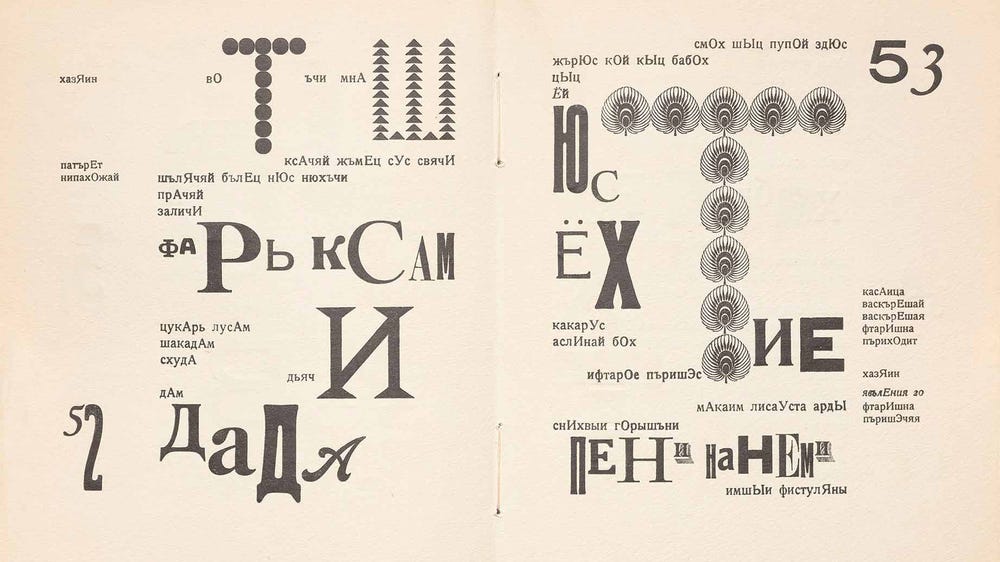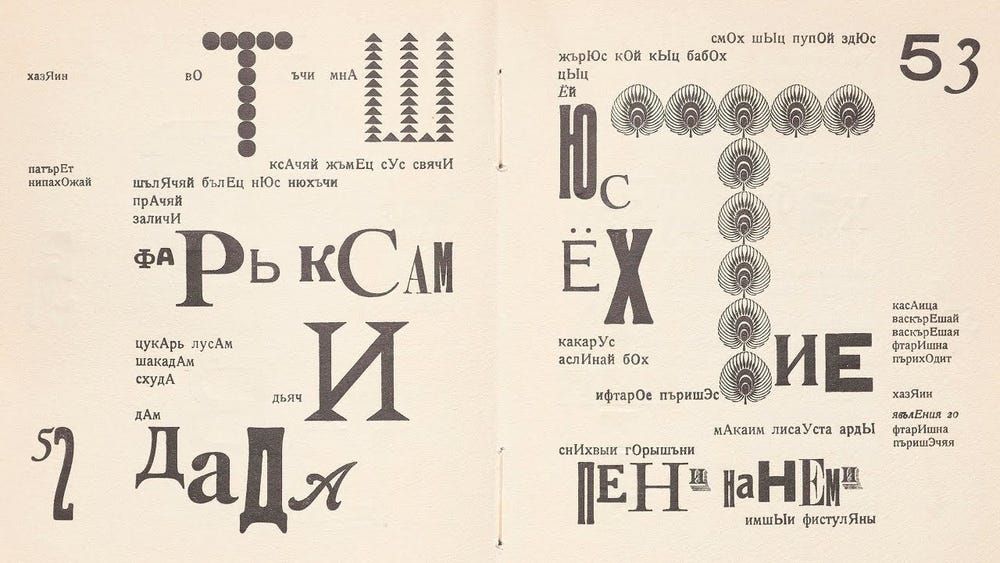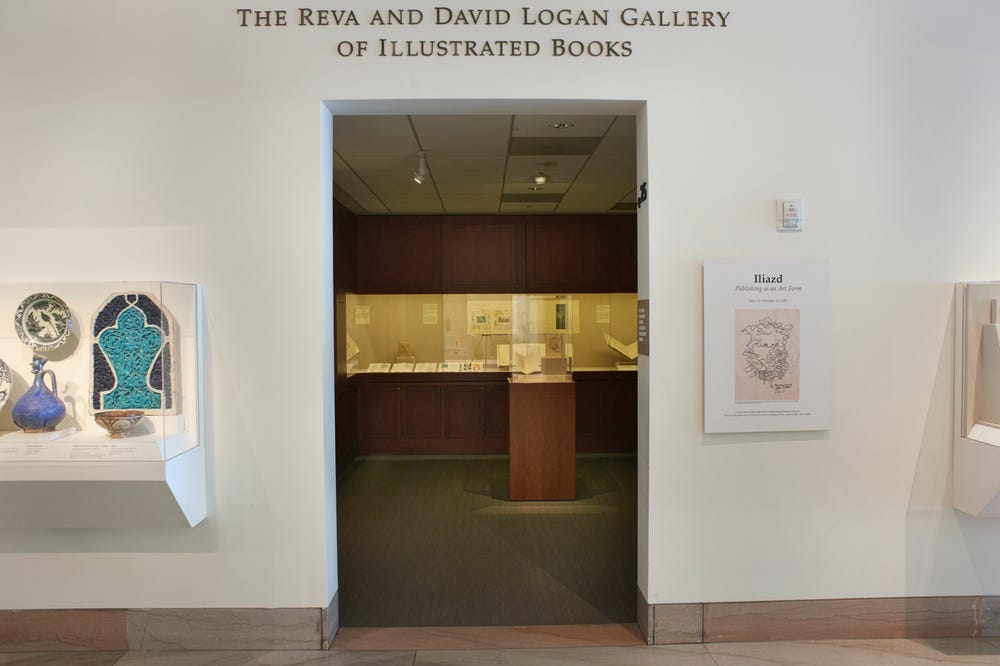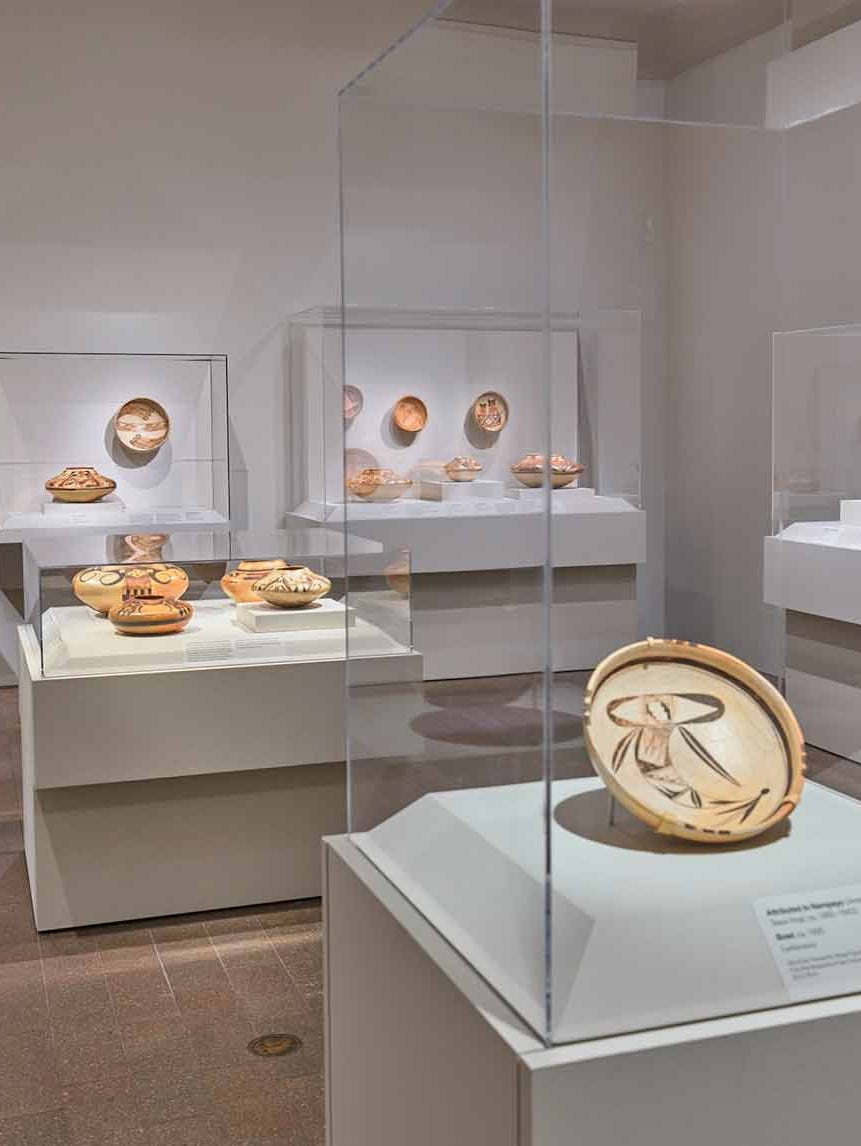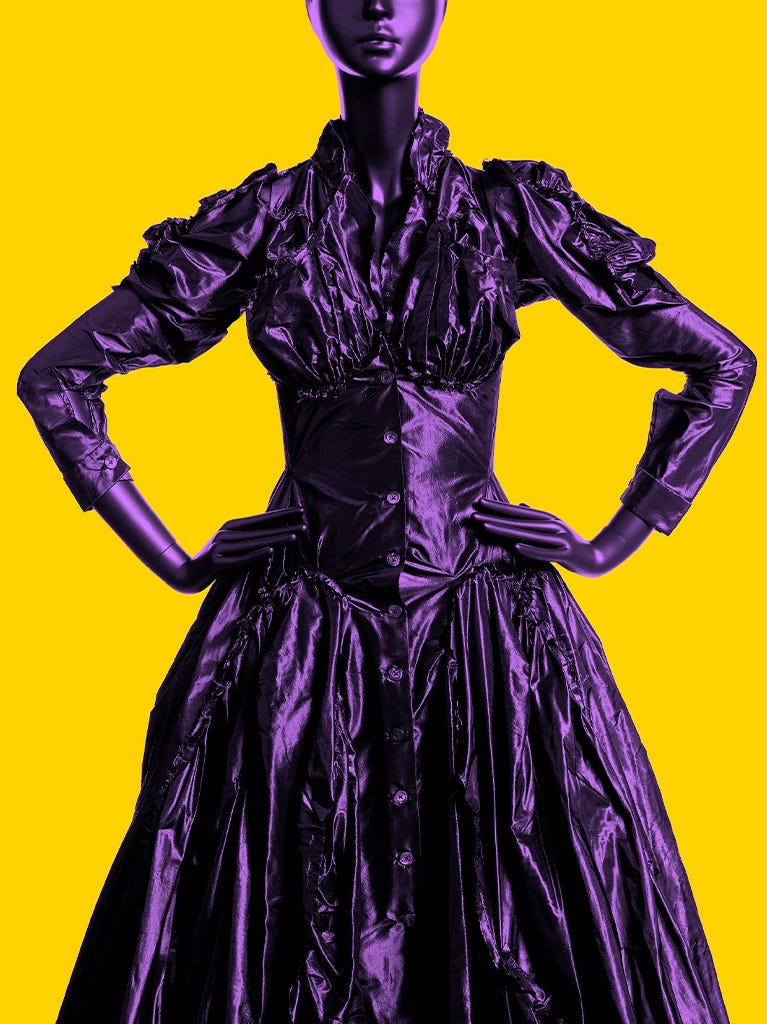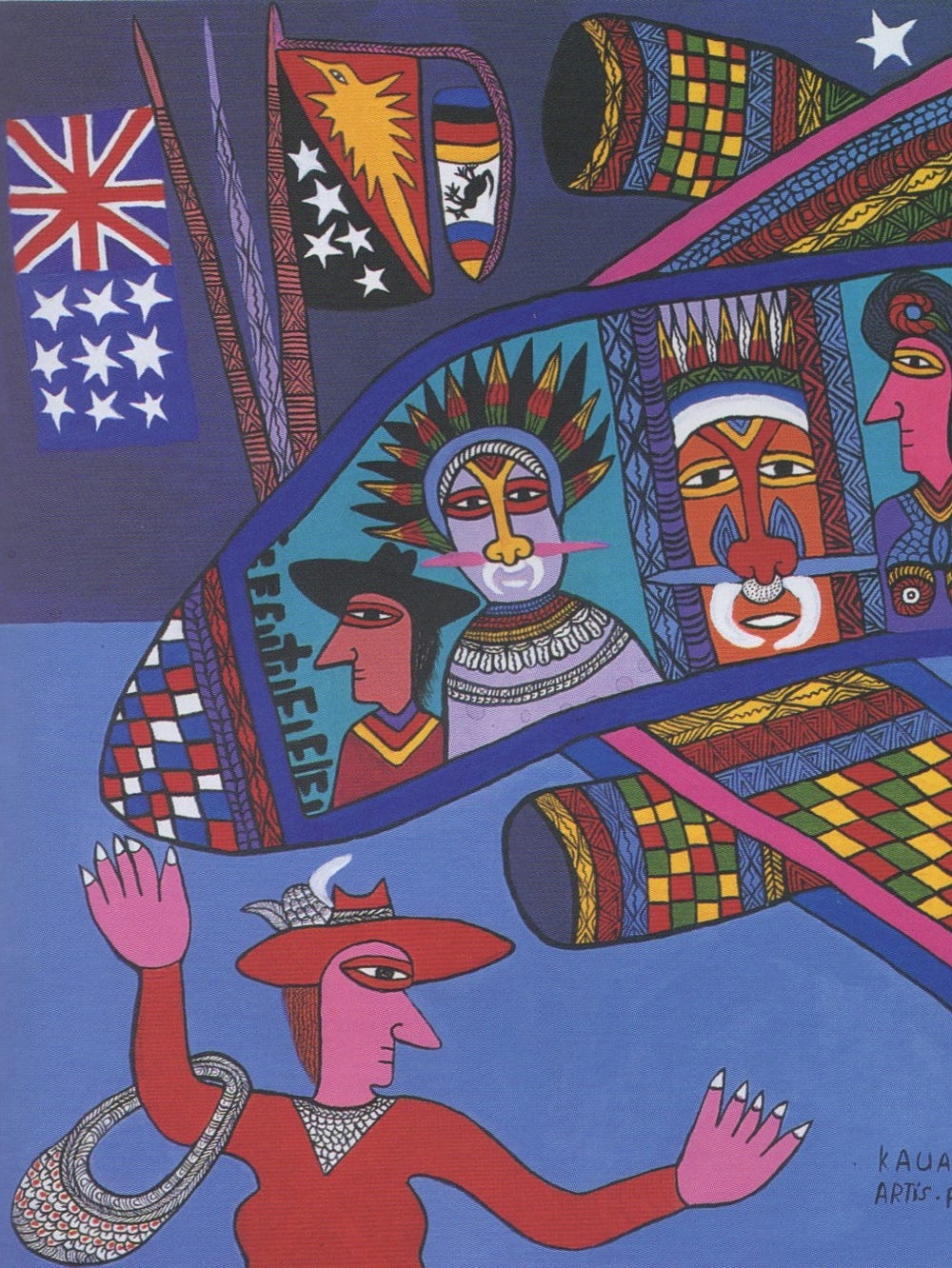Naum Granovsky / Iliazd, LidantYU fAram (Ledentu as Beacon), 1923. Pages 52 and 53, Book With 1 Etching With Collaged Embossed Papers On Front Wrapper; Text Printed On Rubel Paper; Green Wrappers With Collage Of Cork, Gold And Silver Paper On Front; Separate 8-page Prospectus In French Entitled Le Dentu Le Phare (Ledentu The Beacon); Unopened Pages. 194 x 144 x 12 mm (7 5/8 x 5 11/16 x 1/2 in.). Fine Arts Museums of San Francisco, Gift of the Reva and David Logan Foundation, 1998.40.57.1-1
Iliazd: Publishing as an Art Form
Jump to
Drawn from the formidable collection of Ilia Zdanevich’s work in the Reva and David Logan Collection of Illustrated Books, Iliazd: Publishing as an Art Form will look at the work of this Russian Modernist whose collaborators included Pablo Picasso, Georges Braque, Alberto Giacometti, Max Ernst, and Joan Miró. Ilia Zdanevich (Iliazd) created and published twenty-one artist’s books while working in Paris from 1921 – 1975, sixteen of which currently are in the Fine Arts Museums’ collection. This will be the first US museum exhibition devoted to the work of this under-recognized artist in more than thirty years.
Ilia Zdanevich (1894 – 1975), a Georgian deeply rooted in the Russian Futurist movement, came to Paris in 1921, where he made himself known as “Iliazd.” He created and published twenty-one artist’s books in Paris, with a list of collaborators that included many of the most famous artists of his time, all of whom considered him a singular kind of genius. Iliazd was not a publisher in the conventional sense but rather a self-publishing book artist who commissioned his more famous peers to produce images for his books. By creating new, expressive visual forms for literature and using the book’s typography, structure, and materiality to create an interactive experience, he advanced a conception of the book as a hybrid work of art.
In depth
The Book as a Built Environment — Architecture, Materials, Typography
Iliazd approached the design of the books as an architect would a building, leading the reader through constructed spaces. With Pismo, the books began to evolve structurally to take on qualities appropriate to spaces of sacred ritual or theatrical performance. In many cases, an opening series of blank pages of handmade paper serves as a meditative silent space, evoking the hush one encounters upon entering a cathedral. Iliazd then creates a rhythm for the exposition of text and image, often with unexpected folds and text layouts. These unconventional formats disrupt the normal process of reading and engage the viewer as a participant in the narrative’s unfolding. Iliazd was stringent with artists, regardless of their fame. He sent them engraving plates in specific dimensions, the placement and scale of the images calculated for their performative function within the text. Pablo Picasso never accepted those strict restraints from another publisher, but for Iliazd he willingly complied.
Iliazd and “Everythingism”
“I do not publish editions for monetary gain. I struggle. . . . [I]f I published such and such an author, it is always to bring attention to an unknown . . . to turn the tide of ideas toward him, to revise, once again, human values.”
— Iliazd, letter to Joan Miró, May 4, 1962
Shortly after arriving in Paris, Iliazd said goodbye to his Futurist past but always retained the core vision of “Everythingism” (vsiochestvo), a term he had coined to assert the relevance of expression in all media and from all eras. In subsequent years, his broad interests only strengthened his vsiochestvo, manifested in his penchant for spotlighting obscure, diverse figures, mostly from past centuries, and illuminating their texts with expressive typography and images by major artists. This approach is seen in La Maigre, Le Frère mendiant, Chevaux de minuit, 65 Maximiliana, Le Courtisan grotesque, and Pirosmanachvili.
Iliazd’s Legacy
“The idea that books were not vehicles for distribution, but unique forms of expression, became a central tenet of [Iliazd’s] approach.”
— Johanna Drucker, Iliazd: A Meta-Biography of a Modernist
However valuable it may be on its own terms, the livre d’artiste is most often regarded not as an artwork in itself, but rather as a high-concept container for a suite of fine art prints. In deviating from this norm, Iliazd transcended the genre. Looking at his books today, we see the deep thinking and ingenuity that were the foundations of his practice. We can also see why prominent artists wanted to work with him. With Iliazd, they were collaborators in the creation of complex, hybrid works of art — visual literature. The realization of the book itself as a unified work of art is Iliazd’s enduring legacy.
An illustrated book by Iliazd is a book by Iliazd, and not a book by Picasso, Miró, or Max Ernst. . . . a standalone work of art just like a painting, a sculpture, a monument, a film. And Iliazd is its true and sole creator. Louis Barnier, director of the Imprimerie Union, Paris, 1974
Virtual Programs
Opening Iliazd: Publishing as an Art Form \\ Day One
- Introduction
Stephen Woodall, Collections Specialist, Achenbach Foundation for Graphic Arts - Keynote Address - The Iliazd Biography: Archival Research and Personal Encounters
Johanna Drucker, Breslauer Professor of Bibliographical Studies and Distinguished Professor of Information Studies, UCLA - Iliazd as a Focus of Collecting
Timothy Young, Curator of Modern Books and Manuscripts, Beinecke Library, Yale University - Iliazd by Design: Drama and Performance in Book Form
Kitty Maryatt, book artist and former Director, Scripps College Press - Group discussion
Opening Iliazd: Publishing as an Art Form \\ Day Two
- Introduction
- Ilia Zdanevich, the Parisian Avant-Garde, and the Russians
Andrei Ustinov, PhD, Stanford University, scholar of Russian Futurism - “GRACE SHOOTS THROUGH ALL THE WORLD”: Designing Books to Read like Poems
Thomas J. Kitson, PhD, Columbia University, translator living in New York City - Le Courtisan grotesque: Iliazd’s Final Conception of the Illustrated Book
David Sume, PhD, University of Montreal, researcher focusing on the structural properties of Iliazd’s books - Group discussion
